| Solar eclipse of August 31, 1913 | |
|---|---|
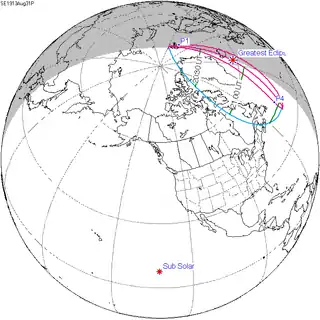 Map | |
| Type of eclipse | |
| Nature | Partial |
| Gamma | 1.4512 |
| Magnitude | 0.1513 |
| Maximum eclipse | |
| Coordinates | 61°30′N 26°48′W / 61.5°N 26.8°W |
| Times (UTC) | |
| Greatest eclipse | 20:52:12 |
| References | |
| Saros | 114 (71 of 72) |
| Catalog # (SE5000) | 9312 |
A partial solar eclipse occurred on August 31, 1913.[1][2] A solar eclipse occurs when the Moon passes between Earth and the Sun, thereby totally or partly obscuring the image of the Sun for a viewer on Earth. A partial solar eclipse occurs in the polar regions of the Earth when the center of the Moon's shadow misses the Earth.
Related eclipses
Solar eclipses of 1913–1917
This eclipse is a member of a semester series. An eclipse in a semester series of solar eclipses repeats approximately every 177 days and 4 hours (a semester) at alternating nodes of the Moon's orbit.[3]
| Solar eclipse series sets from 1913–1917 | ||||
|---|---|---|---|---|
| Descending node | Ascending node | |||
| 114 | August 31, 1913 Partial |
119 | February 25, 1914 Annular | |
| 124 | August 21, 1914 Total |
129 | February 14, 1915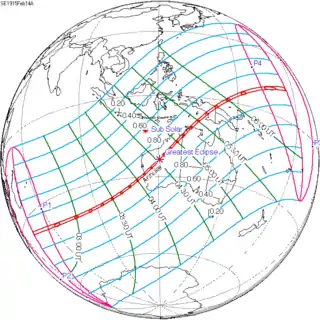 Annular | |
| 134 | August 10, 1915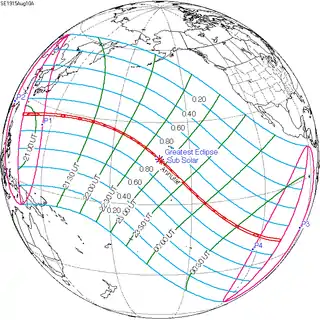 Annular |
139 | February 3, 1916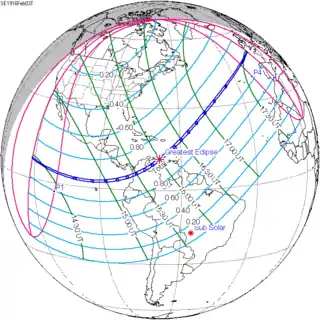 Total | |
| 144 | July 30, 1916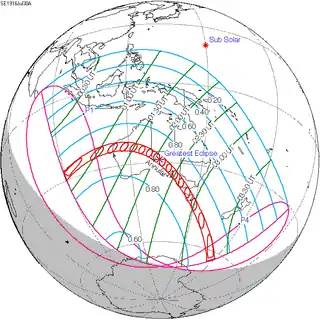 Annular |
149 | January 23, 1917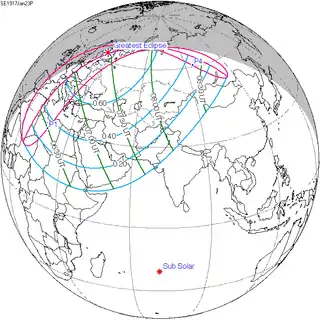 Partial | |
| 154 | July 19, 1917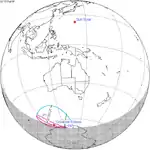 Partial | |||
Metonic series
The metonic series repeats eclipses every 19 years (6939.69 days), lasting about 5 cycles. Eclipses occur in nearly the same calendar date. In addition, the octon subseries repeats 1/5 of that or every 3.8 years (1387.94 days).
| 22 eclipse events, progressing from north to south between April 8, 1902, and August 31, 1989: | ||||
|---|---|---|---|---|
| April 7–8 | January 24–25 | November 12 | August 31-September 1 | June 19–20 |
| 108 | 114 | 116 | ||
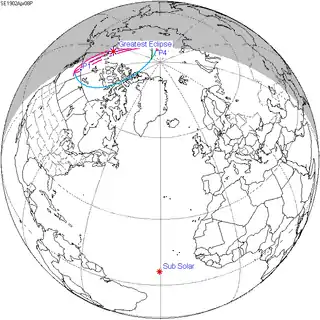 April 8, 1902 |
 August 31, 1913 |
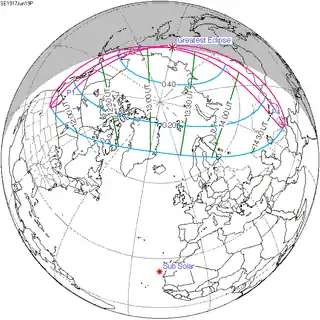 June 19, 1917 | ||
| 118 | 120 | 122 | 124 | 126 |
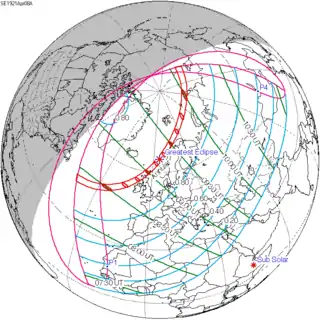 April 8, 1921 |
 January 24, 1925 |
 November 12, 1928 |
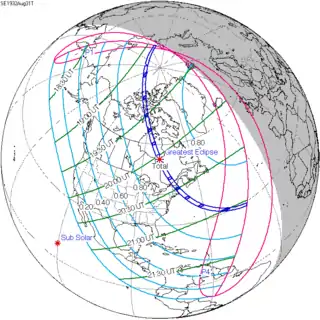 August 31, 1932 |
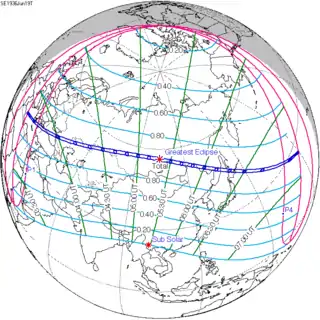 June 19, 1936 |
| 128 | 130 | 132 | 134 | 136 |
 April 7, 1940 |
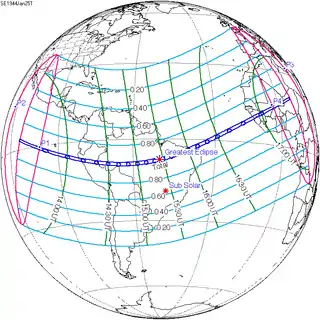 January 25, 1944 |
 November 12, 1947 |
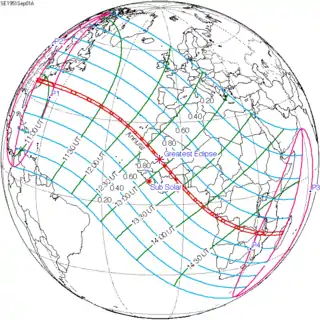 September 1, 1951 |
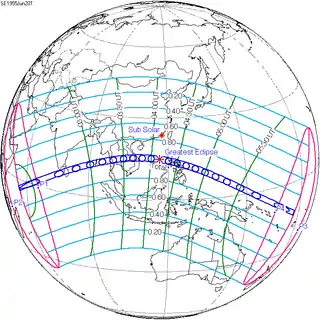 June 20, 1955 |
| 138 | 140 | 142 | 144 | 146 |
 April 8, 1959 |
 January 25, 1963 |
 November 12, 1966 |
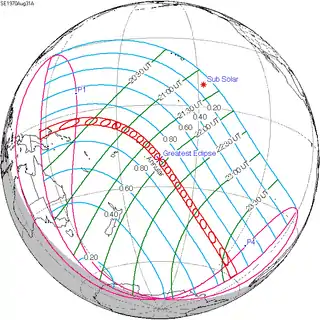 August 31, 1970 |
 June 20, 1974 |
| 148 | 150 | 152 | 154 | |
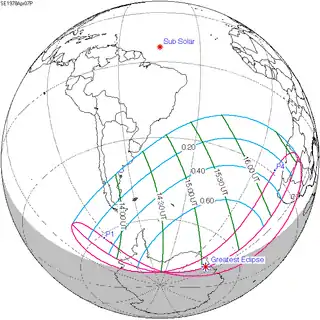 April 7, 1978 |
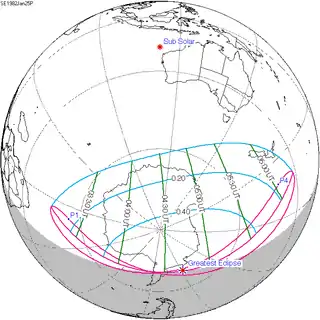 January 25, 1982 |
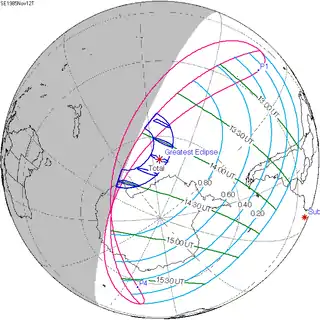 November 12, 1985 |
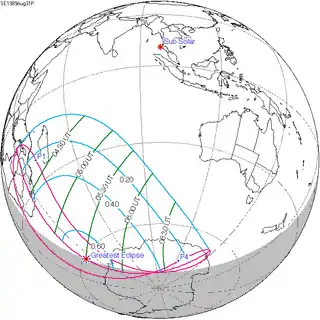 August 31, 1989 | |
References
- ↑ "THREE ECLIPSES IN NEXT TWO MONTHS". The Roanoke Times. Roanoke, Virginia. 1913-08-13. p. 3. Retrieved 2023-11-04 – via Newspapers.com.
- ↑ "The second solar eclipse of the year". Star Tribune. Minneapolis, Minnesota. 1913-08-31. p. 28. Retrieved 2023-11-04 – via Newspapers.com.
- ↑ van Gent, R.H. "Solar- and Lunar-Eclipse Predictions from Antiquity to the Present". A Catalogue of Eclipse Cycles. Utrecht University. Retrieved 6 October 2018.
External links
- Earth visibility chart and eclipse statistics Eclipse Predictions by Fred Espenak, NASA/GSFC
.jpg.webp)

